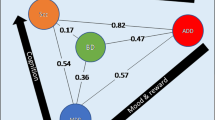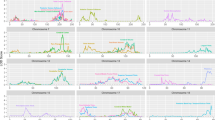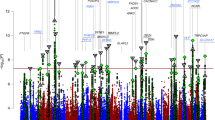Abstract
The main clinical feature of bipolar affective disorder is a change of mood to depression or elation. Unipolar disorder, also termed majc depressive disorder, describes the occurrence c depression alone without episodes of elevate mood. Little is understood about the underlyim, causes of these common and severe illnesse which have estimated lifetime prevalences in th region of 0.8% for bipolar and 6% for unipola disorder1. Strong support for a genetic aetiolog is found in the familial nature of the condition, th increased concordance of monozygotic ove dizygotic twins2 and adoption studies showing increased rates of illness in children of affecte parents3. However, linkage studies have met wit mixed success. An initial report of linkage on th short arm of chromosome 11 (ref. 4) was revised5 and remains unreplicated. Reports proposirr cosegregation of genes found on the X chromosome with bipolar illness6 have not been supported by others7. More recently bipolar disorder ha been reported to be linked with markers on chromosomes 18, 21, 16 and a region on the X chromosome8–10 different from those previousl suggested11. We have carried out a linkage stud in twelve bipolar families. In a single family genome search employing 193 markers indicate linkage on chromosome 4p where the marke D4S394 generated a two-point lod score of 4. under a dominant model of inheritance. Thre point analyses with neighbouring markers gave maximum lod score of 4.8. Eleven other bipols families were typed using D4S394 and in all fam lies combined there was evidence of linkage wit heterogeneity with a maximum two-point lo score of 4.1 (θ = 0, α = 0.35).
This is a preview of subscription content, access via your institution
Access options
Subscribe to this journal
Receive 12 print issues and online access
$209.00 per year
only $17.42 per issue
Buy this article
- Purchase on Springer Link
- Instant access to full article PDF
Prices may be subject to local taxes which are calculated during checkout
Similar content being viewed by others
References
Weissman, M.M. et al. Affective disorders in five United States communities. Psycho. Med. 18, 141–153 (1988).
Bertelsen, A., Harvald, S. & Hauge, M. A Danish twin study of manic depressive illness. Br.J. Psychiat 130, 330–351 (1977).
Mendlewicz, J. & Rainer, J.D. Adoption study supporting genetic transmission in manic depressive illness. Nature. 268, 327–329 (1977).
Egeland, J.A. et al. Bipolar affective disorders linked to DNA markers on chromosome 11. Nature. 325, 783–787 (1987).
Kelsoe, J.R. et al. Re-evaluation of the linkage relationship between chromosome 11 p loci and the gene for bipolar affective disorder in the Old Order Amish. Nature. 342, 238–243 (1989).
Baron, M. et al. Genetic linkage between X-chromosome markers and bipolar affective illness. Nature. 326, 289–292 (1987).
Berrettini, W.H. et al. X-Chromosome markers and manic depressive illness. Arch. Gen. Psychiat. 47, 366–373 (1990).
Berrettini, W.H. et al. Chromosome 18 DNA markers and manic depressive illness: Evidence for a susceptibility gene. Proc. Natl. Acad. Sci. USA. 91, 5918–592 (1994).
Straub, R.E. et al. A possible vulnerability locus for bipolar affective disorder on chromosome 21 q 22.3. Nature Genet. 8, 291–296 (1994).
Ewald, H. el al. A possible locus for manic depressive illness on chromosome 16p13. Psychiat. Genet. 5, 71–61 (1995).
Pekkarinen, P., Terwilliger, J., Bredbacka, P.E., Lonnquist, J. & Peltonen, L. Predisposition to bipolar disorder in the genetic isolate of Eastern Finland. Psychiat. Genet. 5, 826 (1995).
St Clair, D.M. et al. Association within a family of a balanced translocation with major mental. illness. Lancet. 336, 13–16 (1990).
Smith, M. et al. desegregation of an 11 q 22.3-9p22 translocation with affective disorder: proximity of the dopamine D2 receptor gene relative to the translocation breakpoint. Am. J. Hum. Genet. 45, A220 (1989).
Curtis, D. & Sham, P. Using risk calculation to implement an extended relative pair analysis. Ann. Hum. Genet. 58, 151–162 (1994).
Lander, E. & Kruglyak, L. Genetic dissection of complex traits: guidelines for interpreting and reporting linkage results. Nature Genet. 11, 241–247 (1995).
Terwilliger, J.D. & Ott, J. Handbook of Human Genetic Linkage. (The Johns Hopkins University Press, Baltimore, 1994).
Sherrington, R. et al. Cloning of the human dopamine D5 receptor gene and identification of a highly polymorphic microsatellite for the DRD5 locus that shows tight linkage to the chromosome 4p reference marker RAF1P1. Genomics. 18, 423–425 (1993).
Reiss, O. et al. Precise mapping of the brain α2-adrenergic receptor gene within chromosome 4p16. Genomics. 19, 298–302 (1994).
Condie, A. et al. Detection of point mutations in the p53 gene: comparison of single-strand conformation polymorphism, constant denaturant gel electrophoresis, and hydroxylamine and osmium tetroxide techniques. Hum. Mutat. 2, 58–66 (1993).
Polymeropoulos, M.H., Swift, R.G. & Swift, M. Linkage of the gene for Wolfram Syndrome to markers on the short arm of chromosome 4. Nature Genet. 8, 95–97 (1995).
Swift, R.G., Perkins, D.O., Chase, C.L., Sadler, D.B. & Swift, M. Psychiatric disorders in 36 families with Wolfram syndrome. Am. J. Psychiat. 148, 775–779 (1991).
Detera-Wadleigh, S.D. et al. Genetic linkage mapping for a susceptibility locus to bipolar illness: chromosomes 2,3,4,7,9,1 Op, 11 p,22 and Xpter. Am. J. Med. Genet. 54, 206–218 (1994).
Sherrington, R. et al. A linkage study with the D5 dopamine receptor in Icelandic pedigrees with multiple cases of manic depression. Psychiat. Genet. 3, 241–245 (1993).
Holik, J. & Coon, H. A linkage study with D5 dopamine and a2c-adrenergic receptor genes in six multiplex bipolar pedigrees. Psychiat. Genet. 4, 121–124 (1994).
Endicott, J. & Spitzer, R.L. A diagnostic interview: the schedule of affective disorders and schizophrenia. Arch. Gen. Psychiat. 35, 837–844 (1978).
Gyapay, G. et al. The 1993-94 Généthon human genetic linkage map. Nature Genet. 7, 246–339 (1994).
NIH/CEPH Collaborative Mapping Group. A comprehensive genetic linkage map of the human genome. Science 258, 67–86 (1992).
Centre (CHLC). A comprehensive human linkage map with centimorgan density. Science 265, 2049–2054 (1994).
He, L. et al. Automated linkage analysis in psychiatric disorders. Am. J. Med. Genet. 60, 192–198 (1995).
Mansfield, D.C. et al. Automation of genetic linkage analysis using fluorescent microsatellite markers. Genomics. 24, 225–233 (1994).
Lander, E. & R Construction of multHocus genetic linkage map in humans. Proc. Natl. Acad. Sci. USA. 84, 2363–2367 (1987).
Weeks, D.E., Sobel, E., O'Connell, J.R. & Lange, K. Computer programs for muttilocus haplotyping of general pedigrees. Am. J. Hum. Gen. 56, 1506–1507 (1995).
Author information
Authors and Affiliations
Rights and permissions
About this article
Cite this article
Blackwood, D., He, L., Morris, S. et al. A locus for bipolar affective disorder on chromosome 4p. Nat Genet 12, 427–430 (1996). https://doi.org/10.1038/ng0496-427
Received:
Accepted:
Issue Date:
DOI: https://doi.org/10.1038/ng0496-427
This article is cited by
-
Challenges in understanding common disease
Genome Medicine (2017)
-
DNA methylation in a Scottish family multiply affected by bipolar disorder and major depressive disorder
Clinical Epigenetics (2016)
-
Genome-wide linkage analysis of 972 bipolar pedigrees using single-nucleotide polymorphisms
Molecular Psychiatry (2012)
-
Convergence of linkage, association and GWAS findings for a candidate region for bipolar disorder and schizophrenia on chromosome 4p
Molecular Psychiatry (2011)
-
A genome screen of 35 bipolar affective disorder pedigrees provides significant evidence for a susceptibility locus on chromosome 15q25-26
Molecular Psychiatry (2009)



